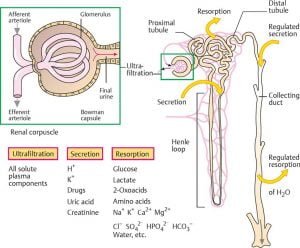Mammals excrete their nitrogenous waste products in the form of urea and hence they are called ureotelic organisms. The urea is produced in liver and filtered in kidney. The urine formation includes the following steps:
- Glomerular Filtration ( Ultrafiltration)
- Tubular/ Selective reabsorption
- Tubular secretion

1. Glomerular Filtration
The blood enters the glomerulus through afferent arteriole and leaves by efferent arteriole. The afferent arteriole has wider lumen then efferent arteriole. Hence the blood pressure in glomerular capillaries becomes very high so that there is continuous process of filtration under pressure. Thus water and many dissolved substances from the blood are filtered into the lumen of Bowman’s capsule through its wall. The afferent arterioles supplying blood to glomerular capsule carries useful as well as harmful substances. The useful substances are glucose, aminoacids, vitamins, hormones, electrolytes, ions etc and the harmful substances are metabolic wastes such as urea, uric acids, creatinine, ions, etc. Molecules smaller than 3nm (such as water, glucose, amino-acids and nitrogenous wastes) in diameter pass easily to renal tubule. Larger molecules pass with difficulty whereas molecules greater than 7-9 nm cannot pass to renal tubule.
The net filtration pressure (NFP) is responsible for filtrate formation.
- The glomerular hydrostatic pressureforces the blood to leaves the glomerulus resulting in filtration of blood. A capillary hydrostatic pressure of about 7.3 kPa (55 mmHg) builds up in the glomerulus. However this pressure is opposed by the osmotic pressure of the blood, provided mainly by plasma proteins, about 4 kPa (30 mmHg), and by filtrate hydrostatic pressure of about 2 kPa (15 mmHg) in the glomerular capsule.
- The net filtration pressure is,
Therefore: 55-(30 +15) = 10mmHg.
- By the net filtration pressure of 10mmHg, blood is filtered in the glomerular capsule.
Glomerular filtration rate (GFR) depends on Net filtration pressure, which is only regulated by changing glomerular capillary hydrostatic pressure.
◘ 180 liters/day; 125 ml/min
◘ 99% reabsorbed; 1% forms excreted urine. Hence, 1.25ml/min
2. Tubular / Selective Reabsorption
The globular filtrate in Bowman’s capsule flows through the convoluted tubule into the collecting tubule and then into the pelvis of kidney and down to the ureter to the bladder. As the glomerular filtrate pass through the proximal convoluted tubule (PCT) water and other physiologically important solutes such as glucose, vitamins, amino acids and inorganic salts like Sodium chloride and Sodium bicarbonate are reabsorbed into the blood in the capillaries around this portion of tubule. The remaining constituents are the waste products to be excreted.
Reabsorption is influenced by:
- Parathormone and calcitonin hormones regulate reabsorption of calcium and phosphate.
- Antidiuretic hormone (ADH) affects the permeability of DCT and collecting tubules regulation water reabsorption.
- Aldosterone (from adrenal cortex) influence reabsorption of Sodium and excretion of Potassium.
The reabsorption may be active or passive. Mostly urea, creatinine and uric acid are not reabsorbed. Urea and creatinine are large enough to diffuse through the membrane pore.
3. Tubular Secretion
It is the selective process involving both passive and active transport. As the blood travels through glomerulus some harmful / unwanted substances may not be cleared from the blood by filtration. Because of short time. Such substances are cleared by secretion into the convoluted tubules. (PCT and DCT).
Substances like H+ , K+, NH4+, creatinine, certain organic acids and medicines (Penicillin, aspirin etc. ) move either from blood of the peritubular capillaries through the tubule cells or directly from the tubule cells into filtrate. Thus, urine eventually excretes filtered and secreted substances.
Tubular secretion is also important to maintain blood pH.
Composition of Urine
Water: 95% ; Urea: 2.6%
Uric acid (0.3%), Chloride, Sodium, Potassium, Creatinine, Hippuric acid
- Other dissolved ions, inorganic and organic compounds (proteins, hormones, metabolites)
Normal urine is transparent and straw colored. The pale yellow color is due to presences of pigment called urobilin. Generally, urine is acidic with pH 6. Urine has bad smell due to urinoid and it soon gets strong smell due to degradation of urea to ammonia.
A healthy adult passes 1 to 1.5 litre urine per day.
Micturition
It is the process by which the urinary bladder empties when it becomes filled. Urinary bladder stores urine for sometimes when 200-300ml urine is collected, autonomic nerve fibers are stimulated which causes opening of urethra resulting in outflow of urine. In adult, micturition can be controlled by conscious effort.